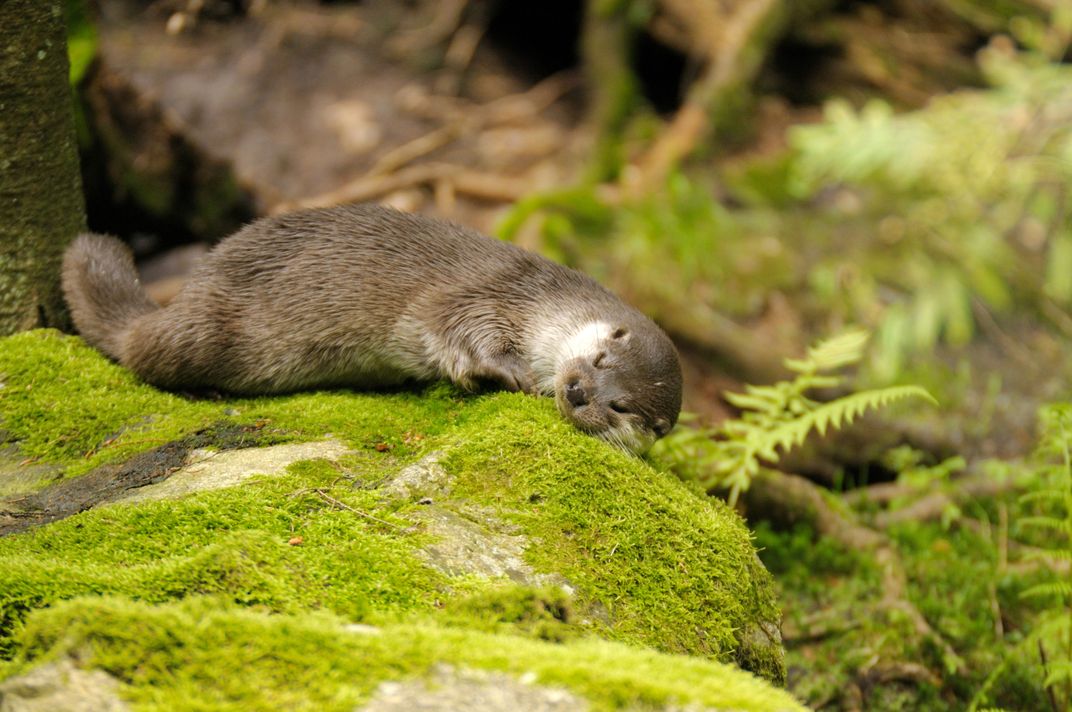You Wouldn’t Want to Cuddle This Giant Prehistoric Otter With a Crushing Bite
The “badger otter” has some serious teeth, which had mystified paleontologists until now
/https://tf-cmsv2-smithsonianmag-media.s3.amazonaws.com/filer/1f/73/1f732b4a-d592-47ad-ad68-74ded065454b/figure_13_siamogale_scene.jpg)
Picture an otter, and you’ll probably see a peaceful beast gamboling in tranquil seas. Otters are so charismatic, in fact, it’s easy to forget that they also use rocks to brutally bust open sea urchins and other mollusks. Now, paleontologists have uncovered a fossil from the coal-rich strata of an ancient wetland that brings the otter’s true nature home: cute as they are, otters have been literally crushing it for millions of years.
This new, burly otter has a bit of a mysterious backstory. In 1983 paleontologists described what they thought was a new fossil otter—Siamogale thailandica—from a single molar found in Thailand. But a later study suggested that the animal the tooth belonged to was more like a European badger, and even the discovery of additional teeth did little to resolve where this mammal fit in the carnivoran family tree. Now, thanks to expeditions in China, the mammal's true identity has been revealed.
From the fossiliferous wealth held in the 6.2 million-year-old sediment of the Shuitangba coal mine in Yunnan, China, a team of Chinese and American scientists have now described Siamogale melilutra. There are parts of at least three skeletons from this new species of Miocene mammal. But it’s a partly-crushed skull that solves the longstanding riddle once and for all: Siamogale is definitely an otter. Albeit a badger-ish one.
Although time was not kind to the Siamogale skull, the fossil shows significant traits that both solidify its status as an otter and explain why there was some prior confusion over its identity. Part of the rear of the skull called the mastoid bears some telltale otter traits, Natural History Museum of Los Angeles paleontologist Xiaoming Wang and colleagues write, but the first molar—the first piece of Siamogale thailandica found back in the 80s—does look a bit look the same tooth in badgers. The end result is a bulky otter with a few hints of badger-like anatomy about it.
“It has the skull of an otter but shares many dental similarities with badgers,” Wang says, “which is why we called it melilutra”—which is Latin for “badger otter.” The results are published today in the Journal of Systematic Palaeontology.

At the time Siamogale was alive, Shuitangba was a wooded wetland, says Cleveland Museum of Natural History paleoecologist Denise Su. “This is in contrast to what was happening globally, with increased aridification and cooling,” says Su, a coauthor on the paper who been tasked with working out the ecology of the site. This might explain why Shuitangba seems to have mammals different from those found elsewhere, including apes and tapirs that had vanished from other places.
“Shuitangba may have been an example of refugia habitats that were present during the latest Miocene that allowed some of the mammalian species adapted for a warmer and stable climate to survive into the Pliocene,” Su says. In other words, this strange creature may have be a straggler from an earlier time, preserved thanks to a protected environment that persisted while the rest of the world changed.
Putting together this broader picture was no easy task, nor was getting a good look at the badger otter itself. Even though Siamogale melilutra is one of the best-preserved mammals from the Shuitangba site, Wang says, “it has been badly crushed into a pancake-like shape.” Study coauthor Stuart White spent months piecing scans of each element and shard into place to create a reconstructed vision of the otter.
What’s certain is that the new beast was a bulky one: With an estimated weight of 110 pounds, it was about the size of a modern-day wolf. “The fossil otter is larger than all living otters,” Wang says. Yet although many meat-eating mammals evolve larger sizes to tackle bigger prey, Wang says, he expects that the size of Siamogale owes to a different cause. The mammal’s teeth hint that Siamogale was a mollusk eater, Wang points out, similar to modern sea otters. But while sea otters use rocks to crack open their hard-shelled food, it’s unlikely Siamogale did the same.
“Perhaps our fossil otter has not learned to use rocks,” Wang muses, “and instead applied brute strength to crush hard shells?” Future studies may answer this paleobiological puzzle, but at least there is now more to study than the tooth, the whole tooth, and nothing but the tooth.
/https://tf-cmsv2-smithsonianmag-media.s3.amazonaws.com/accounts/headshot/RileyBlack.png)
/https://tf-cmsv2-smithsonianmag-media.s3.amazonaws.com/accounts/headshot/RileyBlack.png)